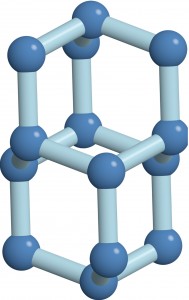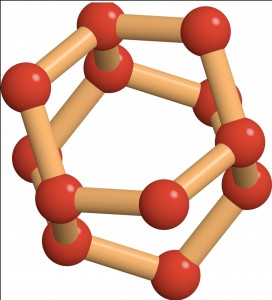 By Catherine Zandonella, Office of the Dean for Research
By Catherine Zandonella, Office of the Dean for Research
Researchers at Princeton University have for the first time directly calculated the rate at which water crystallizes into ice in a realistic computer model of water molecules. The simulations, which were carried out on supercomputers, provide insight into the mechanism by which water transitions from a liquid to a crystalline solid.
Understanding ice formation adds to our knowledge of how cold temperatures affect both living and non-living systems, including how living cells respond to cold and how ice forms in clouds at high altitudes. A more precise knowledge of the initial steps of freezing could eventually help improve weather forecasts and climate models, as well as inform the development of better materials for seeding clouds to increase rainfall.
The researchers looked at the process by which, as the temperature drops, water molecules begin to cling to each other to form a blob of solid ice within the surrounding liquid. These blobs tend to disappear quickly after their formation. Occasionally, a large enough blob, known as a critical nucleus, emerges and is stable enough to grow rather than to melt. The process of forming such a critical nucleus is known as nucleation.
To study nucleation, the researchers used a computerized model of water that mimics the two atoms of hydrogen and one atom of oxygen found in real water. Through the computer simulations, the researchers calculated the average amount of time it takes for the first critical nucleus to form at a temperature of about 230 degrees Kelvin or minus 43 degrees Celsius, which is representative of conditions in high-altitude clouds.
They found that, for a cubic meter of pure water, the amount of time it will take for a nucleus to form is about one-millionth of a second. The study, conducted by Amir Haji-Akbari, a postdoctoral research associate, and Pablo Debenedetti, a professor of chemical and biological engineering, was published online this week in the journal Proceedings of the National Academy of Sciences.
“The main significance of this work is to show that it is possible to calculate the nucleation rate for relatively accurate models of water,” said Haji-Akbari.


In addition to calculating the nucleation rate, the researchers explored the origin of the two different crystalline shapes that ice can take at ambient pressure. The ice that we encounter in daily life is known as hexagonal ice. A second form, cubic ice, is less stable and can be found in high-altitude clouds. Both ices are made up of hexagonal rings, with an oxygen atom on each vertex, but the relative arrangement of the rings differs in the two structures.
“When water nucleates to form ice there is usually a combination of the cubic and hexagonal forms, but it was not well-understood why this would be the case,” said Haji-Akbari. “We were able to look at how the shapes of ice blobs change during the nucleation process, and one of the main findings of our work is to explain how a less stable form of ice is favored over the more stable hexagonal ice during the initial stages of the nucleation process.” (See figure below.)
Debenedetti added, “What we found in our simulations is that before we go to hexagonal ice we tend to form cubic ice, and that was very satisfying because this has been reported in experiments.” One of the strengths of the study, Debenedetti said, was the innovative method developed by Haji-Akbari to identify cubic and hexagonal forms in the computer simulation.
Computer models come in handy for studies of nucleation because conducting experiments at the precise temperatures and atmospheric conditions when water molecules nucleate is very difficult, said Debenedetti, who is Princeton’s Class of 1950 Professor in Engineering and Applied Science and Dean for Research. But these calculations take huge amounts of computer time.
Haji-Akbari found a way to complete the calculation, whereas previous attempts failed to do so. The technique for modeling ice formation involves looking at computer-simulated blobs of ice, known as crystallites, as they form. Normally the technique involves looking at the crystallites after every step in the simulation, but Haji-Akbari modified the procedure such that longer intervals of time could be examined, enabling the algorithm to converge to a solution and obtain a sequence of crystallites that eventually led to the formation of a critical nucleus.

Even with the modifications, the technique took roughly 21 million computer processing unit (CPU) hours to track the behavior of 4,096 virtual water molecules in the model, which is known as TIP4P/Ice and is considered one of the most accurate molecular models of water. The calculations were carried out on several supercomputers, namely the Della and Tiger supercomputers at the Princeton Institute for Computational Science and Engineering; the Stampede supercomputer at the Texas Advanced Computing Center; the Gordon supercomputer at the San Diego Supercomputer Center; and the Blue Gene/Q supercomputer at the Rensselaer Polytechnic Institute.
Debenedetti noted that the rate of ice formation obtained in their calculations is much lower than what had been found by experiment. However, the computer calculations are extremely sensitive, meaning that small changes in certain parameters of the water model have very large effects on the calculated rate. The researchers were able to trace the discrepancy, which is 10 orders of magnitude, to aspects of the water model rather than to their method. As the modeling of water molecules improves, the researchers may be able to refine their calculations of the rate.
The research was funded by the National Science Foundation (Grant CHE-1213343) and the Carbon Mitigation Initiative at Princeton University.
Read the abstract: Haji-Akbari, Amir and Pablo G. Debenedetti. 2015. Direct calculation of ice homogenous nucleation rate for a molecular model of water. Proceedings of the National Academy of Sciences Early Edition. Published online August 3, 2015.
Images courtesy of Amir Haji-Akbari, Princeton University.

You must be logged in to post a comment.